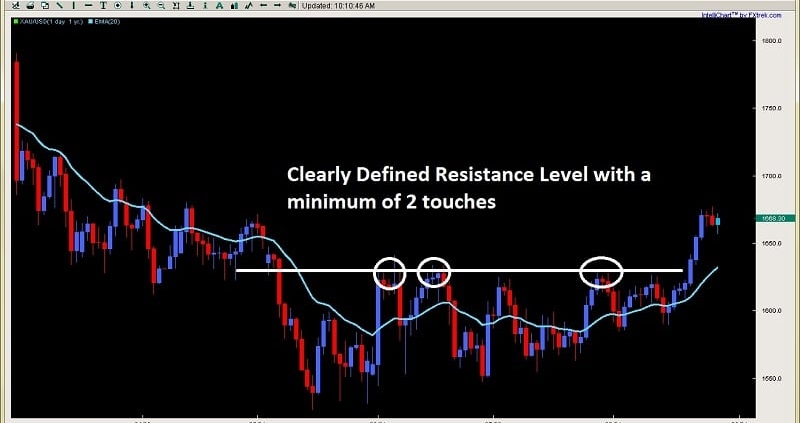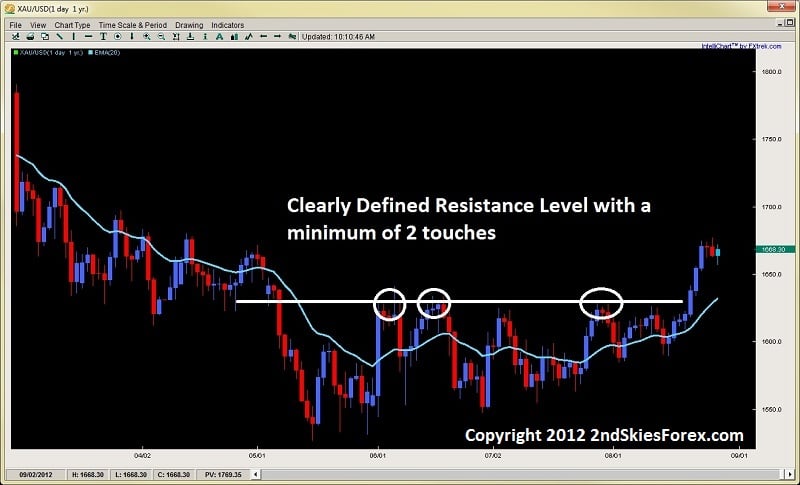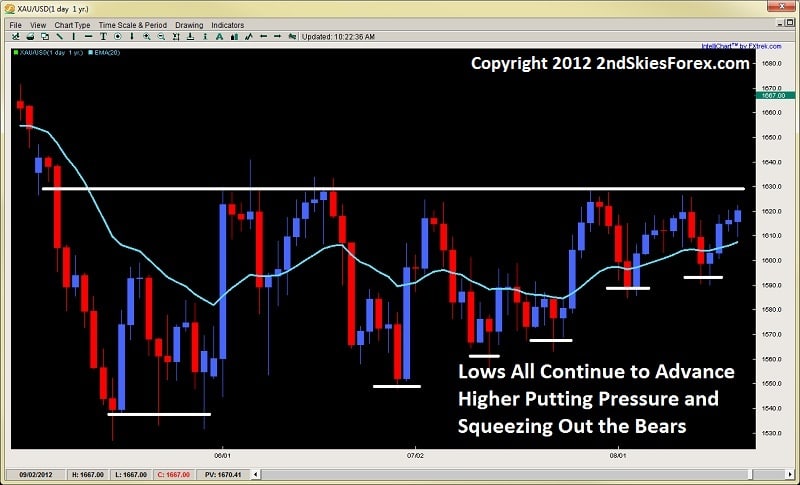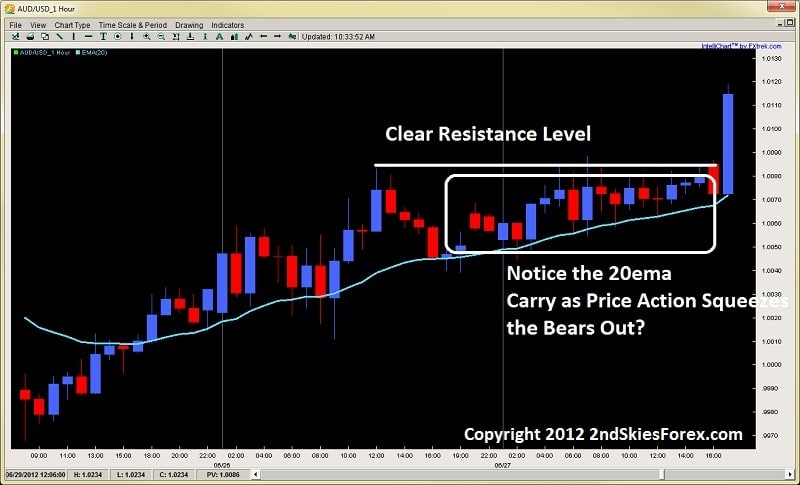3 Keys for Identifying Breakouts
Breakouts are some of the tougher environments for traders, and understandably so because they represent potential, but often fail.
I’ve already written an article for trading breakouts Post-Breakout, but what about the Pre-Breakout moments where you have to make that key decision to trade it or not?
How do you identify them and what are the key elements that precede strong breakouts?
This is the key point of this article – to give you 3 tips for identifying a soon to be strong breakout so you don’t get trapped in a false breakout.
I will go over the three elements you will want to find before considering a breakout, then briefly highlight what is behind them from an order flow perspective. By learning to spot these breakout trading clues, you can position yourself to trade higher probability breakouts and capture a larger portion of the upcoming move.
1) Well Defined Support/Resistance Level
The first pre-requisite to identifying a healthy pre-breakout situation is having a clearly defined barrier in the form of a support or resistance level. The classic case is when you have a trend in place (lets say uptrend) and then the price action runs into resistance at a key level.
Ideally, you want there to be at least two touches on this level before defining it. The more horizontal and neater this level is – the better. But it should be noted, this is just a pre-requisite and generally by itself not enough to identify a healthy breakout setup. The reason for the two touches is to identify a sticking point where players are parked and what level they are defending that the (bulls in this case) are unable to penetrate.
By finding both parties present, we have the environmental potential from an order flow perspective to create a healthy breakout. In this example, the sellers are clearly holding a price they want to defend and have stops just above it. By them staking their defense in a clear location, it communicates where their orders and stops are likely parked. It is tripping those stops, along with bringing in new buyers that is the goal of the bulls.
Below is an example of a clearly defined resistance level after a downtrend and consolidation period, communicating there are bears clearly defending a level.
2) Pre-Breakout Pressure or Tension (Squeeze)
The second element you want present prior to a breakout is a pre-breakout pressure or tension that manifests as a squeeze. This pre-breakout tension is highly important because it creates a friction and pressure upon the defenders (in this case the bears). As the bears realize their rejections off a key level are getting smaller, while the bulls continue to gain more upside and territory, it causes a friction in their minds that forces them to make a critical decision (either stay in and defend, or exit the market).
As the room gets smaller and smaller for them to work with as the bulls squeeze the bears out, sellers defending a level will often exit early, leaving the defense to those who are not realizing the game is up. This further weakens the defenses at these levels until very few are left to carry the burden.
You can easily identify a price action squeeze and this pre-breakout pressure, or tension, by the price action forming higher lows in attacking a resistance level, or lower highs when attacking a support level. This is a combination of the current bulls willing to buy up the instrument at a worse price, along with new bulls wanting to get long before the breakout. A good example is presented in the same chart which I will zoom in on to highlight.
3) 20EMA Carry
Another key element you will find prior to breakouts is the 20ema begins to carry price leading up to the key resistance or support level that is being defended. This is not so much that traders are placing orders there prior to the breakout (although many will), but also a visual representation of how the squeeze is taking place.
Just looking at the chart above, we can see in the beginning, after the first rejection off the key resistance level, price penetrated nicely below the 20ema. But as we get closer and closer towards the right where the squeeze is taking place, you see the market barely go below it for more than a single candle before resurfacing.
Also, you will notice how the first few times the rejection approaches the 20ema, it breaks through after one candle. But towards the end many candles start to float above it where some traders are entering in anticipation of the breakout.
Another really good example was one I traded and blogged about ahead of time with the AUD/USD on the 1hr time frame. The pair had been trending up for 110 pips over two days, but ran into a key resistance level that it got stuck on at 1.0081 (image below).
Using the example above, notice how the 20ema in the middle of the chart is penetrated about 20pips, but then as we get closer and closer to the resistance level and the squeeze begins to happen, notice how the 20ema begins to carry the price action, and the penetrations get smaller and smaller?
This is a combination of very few sellers defending the level, while the bulls in anticipation of a breakout (realizing they have control) are likely entering new positions to get in ahead of the upcoming breakout (I was one such trader). Eventually the pre-breakout pressure and tension became too intense and the bears gave up when the bulls made their push, tripping stops and creating a large breakout bar with a strong close.
In Conclusion
Identifying breakouts can offer highly profitable opportunities when you can position yourself well. But to do this, you must be able to identify highly probable breakouts with these 3 key elements which are;
1) Well Defined Support/Resistance Level
2) Pre-Breakout Pressure/Tension (Squeeze)
3) 20EMA Carry
If you can learn to spot these key elements prior to a breakout, along with reading various other price action clues, you will find yourself entering in higher probability breakouts, increasing your success and profitability. You will also find yourself not getting trapped by false breakouts which can wreak havoc on your account and confidence in trading them. Thus it is critical to read and identify the key elements prior to a breakout.
For more info on how to trade price action, along with lifetime membership, getting access to the traders forum & more, make sure to visit my price action course page.
Other Related Articles:
Trading Breakouts
Key Price Action Elements to Breakouts
Breakout Role Reversal Setups





An EXCELLENT article/lesson on identifying Breakouts. Now, the strategy how to effectively handle potential breakouts is much clearer to me. Chris, thank you so much!
Hello Tasos,
Glad it helped amigo – such a key topic for traders so glad it makes it clearer on how to trade breakouts.
Kind Regards,
Chris
Awesome work as usual Chris. I have been waiting for clarificaiton on identifying potential breakouts for a while now. This is great stuff!!
Hello Andrew,
Glad you liked it and I hope this helps you identify higher probability breakouts.
Kind Regards,
Chris
Hi Chris,
Another bullet for our trading arsenal! Great article Chris. Your explanation of order flow and squeeze play makes everything so clear.
Thanks again…….Cal
Hello Cal,
As always, glad you liked it and good to see you again.
Kind Regards,
Chris
Hi Chris,
I also appreciate our lunch in Amsterdam. You know I am a big fan of trading break-outs and your little expo I have read, after coming back from my holidays, is also very clear, understandable and profitable. See you next time at your webinar. Cheers Johan
Hello Johan,
Pleasure meeting you for lunch. And glad the breakout article/information helped. I also like breakout trading
but glad you found this clear, understandable and profitable.
Kind Regards,
Chris
Thanks for the article. Read over it a second time to ensure I’m catching up on these concepts. One nit request — is there anyway to disable the slideshow by default? I find that I want to stare are the charts for some time to study them.
Hello Yajoe,
Glad you liked the article. In regards to the slideshow, yes, when you click on the chart, there are buttons underneath, one of which says, ‘stop slideshow’ so that should do the trick.
Hope this helps
Kind Regards,
Chris
Always had trouble before trading breakouts, but these price action tips make breakouts seem more manageable.
My friend on forum is a member of your course and says you have really good strategies for trading breakouts.
Will be the next person to sign up.
Hello Chris, when trading for breakout on this pre-requisite , is it based on daily chart or hourly chart?
Sorry for my silly question, as I am still newbie to trading.
Thank you
Hello AdaKiene,
This structure works on any time frame, but the price action context is key.
Kind Regards,
Chris Capre